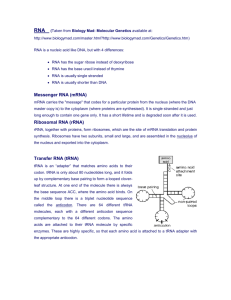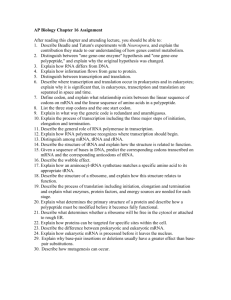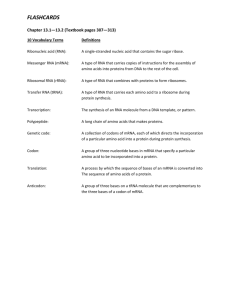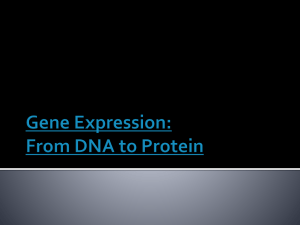DNA 2
advertisement
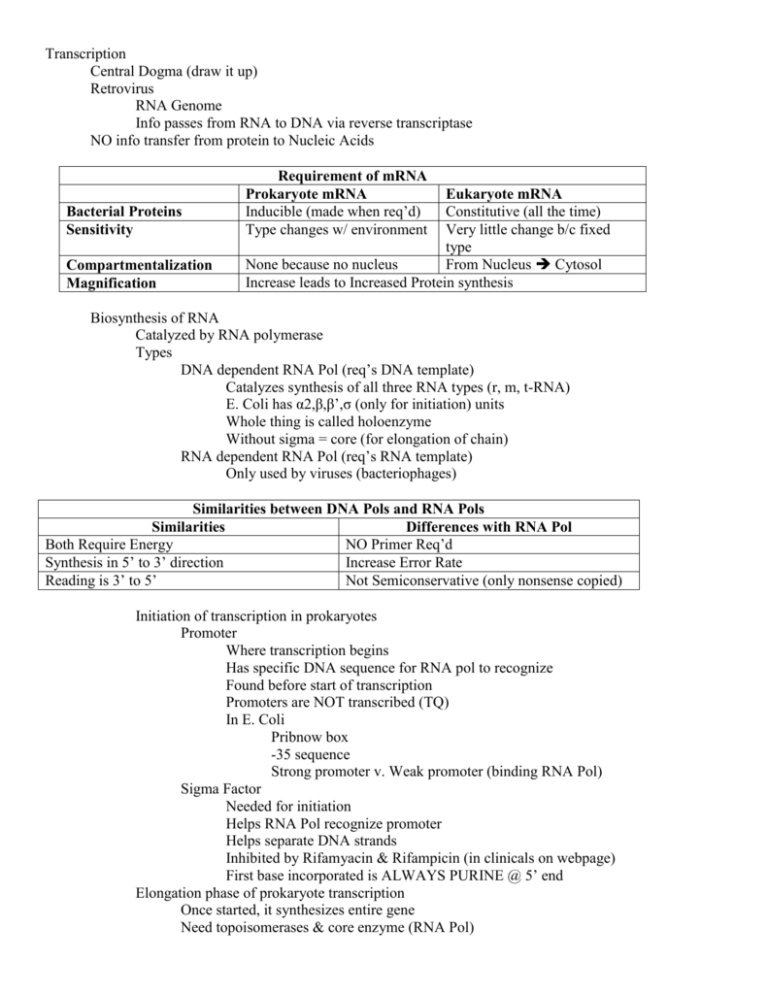
Transcription Central Dogma (draw it up) Retrovirus RNA Genome Info passes from RNA to DNA via reverse transcriptase NO info transfer from protein to Nucleic Acids Bacterial Proteins Sensitivity Compartmentalization Magnification Requirement of mRNA Prokaryote mRNA Inducible (made when req’d) Type changes w/ environment Eukaryote mRNA Constitutive (all the time) Very little change b/c fixed type None because no nucleus From Nucleus Cytosol Increase leads to Increased Protein synthesis Biosynthesis of RNA Catalyzed by RNA polymerase Types DNA dependent RNA Pol (req’s DNA template) Catalyzes synthesis of all three RNA types (r, m, t-RNA) E. Coli has α2,β,β’,σ (only for initiation) units Whole thing is called holoenzyme Without sigma = core (for elongation of chain) RNA dependent RNA Pol (req’s RNA template) Only used by viruses (bacteriophages) Similarities between DNA Pols and RNA Pols Similarities Differences with RNA Pol Both Require Energy NO Primer Req’d Synthesis in 5’ to 3’ direction Increase Error Rate Reading is 3’ to 5’ Not Semiconservative (only nonsense copied) Initiation of transcription in prokaryotes Promoter Where transcription begins Has specific DNA sequence for RNA pol to recognize Found before start of transcription Promoters are NOT transcribed (TQ) In E. Coli Pribnow box -35 sequence Strong promoter v. Weak promoter (binding RNA Pol) Sigma Factor Needed for initiation Helps RNA Pol recognize promoter Helps separate DNA strands Inhibited by Rifamyacin & Rifampicin (in clinicals on webpage) First base incorporated is ALWAYS PURINE @ 5’ end Elongation phase of prokaryote transcription Once started, it synthesizes entire gene Need topoisomerases & core enzyme (RNA Pol) Termination of Transcription in Prokaryotes Rho-Dependent Rho-Independent GC rich region but NO Poly-U stretch at end GC-rich followed by AT-Rich Required Rho factor for termination This region folds on itself and forms hair pin loop Mechanism New RNA and Pol fall off (b/o short AU stretch) 1. RNA Pol reaches Rho site 2. Rho binds to RNA chain (in 5’-3’ ) 3. Meets with RNA Pol 4. Catalyzes release of RNA & Pol Transcription of Eukaryotes Know chart that he gave Know segmentation values (we didn’t have any TQ’s) Three RNA Pol’s Similar to Prokaryotes Synthesis from 5’ to 3’ Requires dNTP No Primer No Proofreading Only one DNA transcribed Differences to Prokaryotes Need a lot of transcription factors Post transcriptional modifications See chart Splicing Introns are junk Exons are coding regions Splicing in nucleus before mRNA goes to cytosol Requires SNURP Spliceosome = SNURP + complementary RNA Introns releases as “lariat” (TQ!!!) Genetic Code It is NOT an overlapping code It is a degenerate code It uses no punctuation except for stop and start signals It is a triple code 61 codons code for amino acids Know how to read the chart Translation Protein Synthesized from N-terminal (met for f-met) mRNA read in 5’ to 3’ direction (TQ!!) Ribosome Prokaryote 50S + 30S = 70S 67% of ribosome is RNA 33% is protein Eukaryote 60S + 40S = 80S 60S = 28S + 5.8S + 5S + 50 proteins 40S = 18S + 30 proteins tRNA Codon is on mRNA Anticodon is on tRNA Base pairs with codon on mRNA corresponding to an amino acid that tRNA carries Different tRNA have different anticodons Codon – Anticodon recognition Some tRNA recognize more than 1 codon tRNA has inosine as modified base Wobble hypothesis First 2 bases at 5’ end of codon interact with bases of anticodon like DNA The first base of anticodon @ 5’ end is under decreased steric hindrance it can wobble relative to 3rd base of codon allows non-standard base pairing to occur Base Pairing First base of anticodon (5’ end) Third base of codon (3’ end) A U C G U A,G G C,U I C,A,U Activation of Amino Acids + ΔG to go from free amino acid to polypeptide Must use ATP to charge amino acid (stored in ester bond btw tRNA & carboxy terminal) Catalyzed by amino acyl tRNA synthETases 20 different activators for 20 different amino acids Mechanism of protein synthesis f-Met f-Met is first amino acid in prokaryotes brought by tRNAf to ribosome two Met specific tRNAs in Eukaryotes 1) initiation 2) internal methionine 1. Formation of Initiation Complex mRNA + f-Met + GTP + transcription factors (IF-1, -2, -3) = 30S unit 30S joins 50S and IF’s released and GTP hydrolyzed f-Met binds to P site (A & P are binding sites for tRNA) decides reading frame for rest of coding region Ribosomes recognize Initiation sites on mRNA via Shine-Dalgarno Sequence Short region in proks before start codon (AUG) FXN: Aligns start codon with ribosome Draw up pictures 2. Elongation Binding of Amino-acyl tRNA tRNA enters and binds to A site on ribosome EF-Tu (delivers tRNA to A site) + GTP Formation of Peptide Bond Catalyzed by peptidyl transferase Produce Dipeptidyl tRNA at A site Uncharged tRNA at P site Gets energy from ATP used in charging (no external energy here) 3. Translocation Uncharged tRNAf leaves the P site Peptidyl tRNA moves from A site to P stie mRNA moves up three bases to move up to next codon requires EF-G & GTP EF-G = EF-2 in eukaryotes 4. Termination of Polypeptide Stop codons UAA, UAG, UGA Recognized by releasing factors Prok’s: RF 1, 2 Recognize Stop codon RF 3 stimulates 1,2; req’s GTP Euk’s: RF recognizes ALL 3 stop codons (TQ) Req’s GTP Post-Translational Modification We can’t make it any simpler Just read his list (No TQ’s) Antibiotics See clinicals Mutations Just read it. He will ask a few questions, but not many


